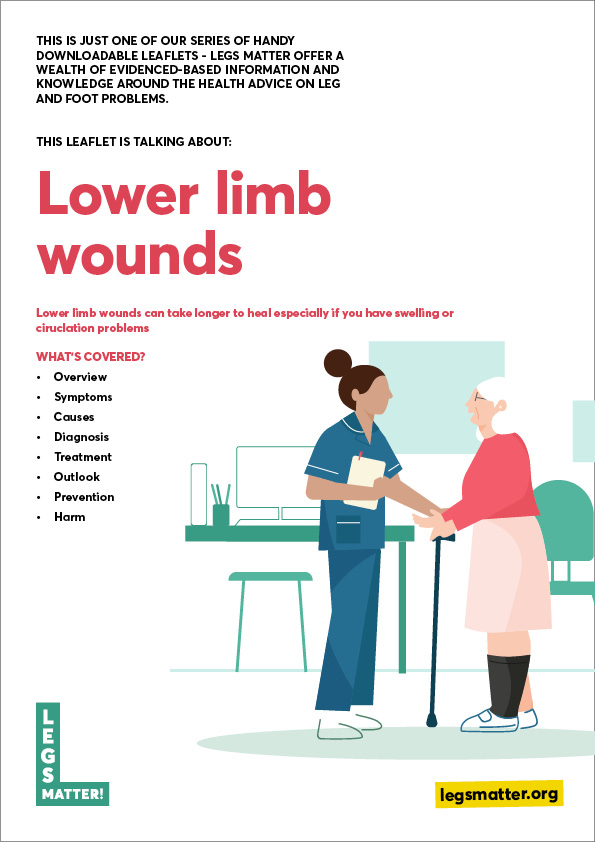Overview – what are lower limb wounds?
Lower limb wounds describe any break to the skin of the legs and feet, this can include:
- Cuts and scratches
- Burns
- Insect bites
- Surgical wounds
- Skin conditions such as eczema that has caused a break to the skin
Wounds to the lower limb can take longer to heal especially if there are problems with your circulation or swelling.
Symptoms – what are the signs / symptoms of lower limb wounds?
Any wound that develops below the knee should be reviewed by a healthcare professional if:
- It shows no signs of healing after 2 weeks
- You have had a previous non healing or hard to heal wound on the leg
- You have a diagnosis of peripheral arterial disease
- You develop swelling to the leg after the injury has occurred
- You have signs of infection including smell from the wound, increasing pain, redness or heat surrounding the wound
Causes of lower limb wounds
Accidental injuries
These can cause:
- Cuts and grazes
- Skin tears – this is a wound where the top layer of the skin separates. This can be caused by bumping your leg against something, or from removal of a sticky dressing. They are more common in the elderly as our skin gets thinner as we age.
- Haematomas – this is a bad bruise. Bruises occur when blood vessels break and small amounts of blood leak under the skin, usually due to an injury or excessive pressure. A haematoma happens when the blood pools and collects under the skin, causing a spongy, rubbery feeling lump.
- Burns
Insect bites
These are not usually serious and should heal in a couple of days, but if they become infected or cause an allergic reaction this can lead to a wound.
Surgical wounds
Any cut through the skin and soft tissues as part of an operation or procedure is a surgical wound.
Depending on the size of the incision and type of wound, it could be closed with glue, stitches (sutures) or staples. Glue and some sutures will dissolve and not need to be removed, staples and non-soluble sutures will need to be removed by a healthcare professional, you should be told this as part of your post-operative information. Sometimes the surgeon might leave the wound open if there is not enough skin to close the wound, or if swelling would put the wound under too much tension. They might leave the wound open to heal from the bottom up or plan for closure of the wound at a later date. If the wound does not heal properly, or opens up this can become a non-healing wound.
Diagnosis of lower limb wounds
Whilst the cause of a lower limb wound can be an injury, the reason for slow healing could have an underlying cause. If there is swelling or even mild venous disease, without this being addressed, the wound can deteriorate and become painful and problematic.
It is really important that the cause of the non-healing is diagnosed so that treatment for this can be identified and understood.
If you have signs of infection, which includes spreading redness / skin colour changes and heat around the wound edges, increasing pain or a bad smell from the wound then you should see your GP and might need antibiotics. If you have signs of infection and are feeling unwell, eg shivering, nausea, temperature then you should get an emergency appointment with your GP/minor injuries or attend A&E. If you are unsure, ring 111.
You should try and be seen in a wound clinic and ask for an ABPI and see whether compression could help your wound to heal if:
- You develop a new wound to your leg and have a history of leg ulcers / slow to heal wounds on the lower limb
- You have not had leg ulcers before, and your leg wound shows no signs of healing, or appears to be worsening after 2 weeks
Treatment – what treatment will I be offered for lower limb wounds?
Simple, new wounds
Soothe and clean your wound with cool clean water, this can be from the tap or cooled boiled water from the kettle. Do not use soap, alcohol or any other cleansing product – water is enough.
Cover with an adhesive wound dressing (eg simple Elastoplast) if the wound is open, leaking, or rubbing on clothes. If you are allergic, or have sensitive skin switch to an adhesive free dressing, you can speak to your pharmacist for advice. Once a scab has formed, you shouldn’t need a dressing unless it is for protection against rubbing.
Burns
Venous leg ulcers
Refer for vascular assessment – read more here.
Outlook for lower limb wounds
A leg wound will heal more slowly than a wound on other parts of the body. The risk of this is reduced when the leg receives support from a compression sock or bandage.
Healing can take weeks but if the wound is static or deteriorating, please seek additional specialist advice. Most wounds heal when the cause and treatment is correctly identified.
Do not expect or accept a non-healing wound, especially if it has a terrible impact on your life. Ask for help and be persistent.
Prevention of lower limb wounds
There are a few things you can do:
- Moisturise limbs to strengthen skin
- Avoid adhesives if you have ‘paper thin skin’ or have had skin tears in the past
- Regularly check the skin on your legs and feet
- Wear light compression socks to support your legs especially if you have swelling
Harm – the risk factors
Inaction or insufficient action on non-healing leg wounds can cause harm as they can become chronic non healing wounds. This includes:
- Not investigating why a wound is not healing
- Not acting on a new wound when there is a history of venous or arterial disease, had a previous leg ulcer or slow to heal wound on the leg
If you have any concerns about the treatment or care you are receiving, it is important to speak up.
Resources
Looking after a wound or skin tear (web page)
Lower limb wounds downloadable leaflet (PDF)
We’ve created a handy downloadable leaflet of the key information on this page so you can easily print it out for personal reference or to hand to a patient or healthcare professional. Or you can also simply forward it on by email.
Other support
Some organisations you can contact for further information.
Accelerate Based in East London, Accelerate can accept national referrals from your GP / specialist to our world-class centre where we pioneer and trial experimental new treatments for chronic leg ulcers / wounds, lymphoedema and mobility challenges.
Contact details
020 3819 6022
hello@acceleratecic.com
Find out more on the Accelerate website
Lipoedema UK Their focus is to educate doctors, health professionals and the public about Lipoedema and its symptoms, so it may be diagnosed and treated earlier. They believe that with earlier diagnosis and treatment women can prevent developing further complications and manage their Lipoedema.
Contact details
info@lipoedema.co.uk
Find out more on the Lipoedema UK website
Royal College of Podiatry The Royal College of Podiatry exists to ensure the public has access to high quality foot care delivered by qualified and regulated professionals.
Contact details
020 7234 8620
reception@rcpod.org
Find out more on the Royal College of Podiatry website
Diabetes UK Diabetes UK are the leading UK charity for people affected by diabetes it’s their responsibility to lead the fight against the growing crisis. And this fight is one that involves all everyone – sharing knowledge and taking diabetes on together.
Contact details
0345 123 2399
helpline@diabetes.org.uk
Find out more on the Diabetes UK website
Tell us what you think
If there’s anything you want to ask us or tell us, whether it’s a suggestion about our website, a complaint, or a compliment, drop us a line at
support@legsmatter.org










